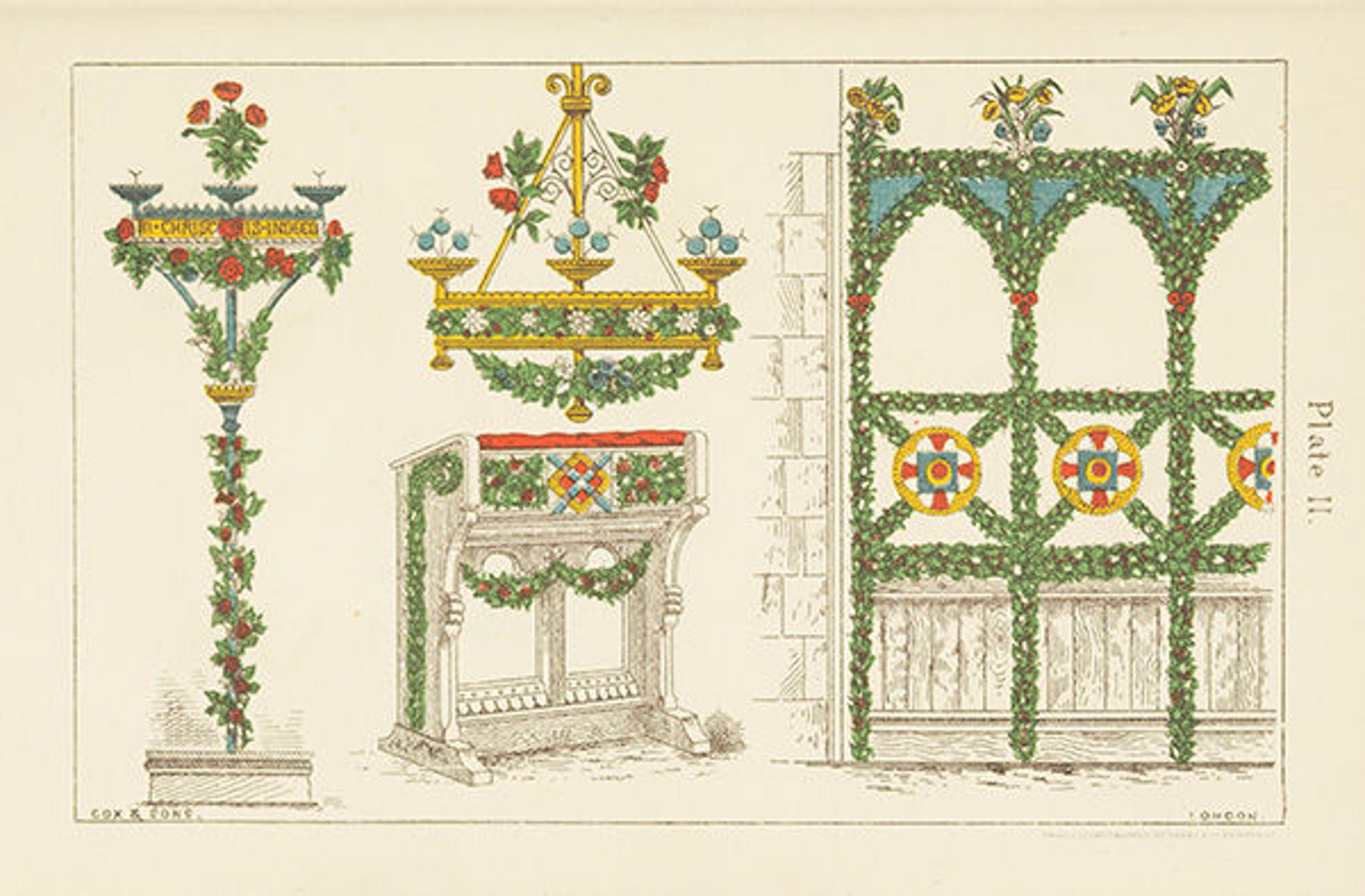O Tannenbaum, O Tannenbaum, Your Branches Green Delight Us!

Plate 11, The Art of Garnishing Churches at Christmas and Other Festivals, 1871
«The holiday season brings fragrant trees into our homes, green wreaths attached to doors, and carpets of pine boughs to the dividers along the uptown stretches of Park Avenue near the Met. In concert with the season, I thought I'd highlight a few items from Watson Library's special collections that feature Christmas decorations and evergreen motifs.»
The Cox & Sons catalogue The Art of Garnishing Churches at Christmas and Other Festivals provides historical background, advice, and guides for holiday decorating. Effectively a long-form advertisement, the publication concludes with several pages of price lists for the firm's products. The third edition includes a greater number of plates, some of which are chromolithographs illustrating some examples of how they might look in situ (for more on chromolithography, see this earlier blog post).
Cox, in chapters such as "Methods of Forming Wreaths" and "Devices In Evergreens" provide instructions for making said decorations, along with suggestions for those products that would best suit the work.

Plate 12, Torten-Verzierungen: 78 Moderne Vorlagen; Eigene Entwürfe mit Klaren Erläuterungen, 1910. Gift of Friends of the Thomas J. Watson Library, 2013
Finer examples of chromolithography are the color plates in Torten-Verzierungen: 78 Moderne Vorlagen; Eigene Entwürfe mit Klaren Erläuterungen, a 1910 Art Nouveau–inspired guide to cake decoration credited to Bavarian confectioner Georg Steinberger. Plate 12 is a suggested design with fir stems and pine cones, and the supplemental insert instructs the decorator to use spraying chocolate (Spritzschokolade) for the branches and the outlines of the needles and pine cones. The needles are to be filled in with green jam (grüner Marmelade) and the cones with brown fondant or marzipan.

Title page (left) and page one (right), Loffice de Noel, 1768. Gift of Jayne Wrightsman, 2008
The 209-page manuscript was produced in 1768 by Baudoin, calligrapher of the Royal Chapel of Versailles, for Bernard René Jourdan, marquis de Launay, who later became the governor of the Bastille. The manuscript contains the liturgy and music for the Christmas holidays and is encased in a very fine and charming red morocco binding depicting de Launay's coat of arms, which includes a cricket standing on a morel (photographs of this binding can be viewed online here). More typical Christmas decorations were added by Baudoin inside: the title page contains a wreath enclosing a shooting star (above left), and several of the section headers include crossed branches—perhaps stylized holly—of leaves and red berries (above right).

Details of plates 25b (No. 163b, "Hunting Trophy, in Fat," left) and 37 (No. 189, "Chaufroix of Fillets of Pheasant," right), Artistic Cookery: A Practical System for the Use of the Nobility and Gentry and for Public Entertainments, by Urban Dubois, 1887. Gift of Friends of the Thomas J. Watson Library, 2012
The holidays are also a time for gathering at the table and enjoying a feast together with friends and family. What most of us will not see on our tables are lavish decorations like the ornamental creations described in the 1887 publication Artistic Cookery: A Practical System for the Use of the Nobility and Gentry and for Public Entertainments, by Urban Dubois. Dubois (1818–1901) served as chef to Prince Orloff of Russia, joint chef to Emperor Wilhelm of Prussia, and published eight cookbooks. The two illustrations here, one ornamental and one edible, come from two of the volume's eighty engraved plates and include fir cones as part of the decoration. Dubois suggests that "The Hunting Trophy, in Fat" (above left, and, yes, somehow made of fat) should be no less than 1 meter, 25 cm (over four feet!) tall, as these types of ornaments are "mostly intended for ball-buffets." The "Chaufroix of Fillets of Pheasant" entrée (above right) is described as "very rich, and very elegant in form . . . but requires to be prepared with great exactitude." The stand on which this pheasant meat pyramid is to be placed includes a "border of small fir-apples."
I hope that these seasonal details from a few Watson Library treasures have added an unexpected dimension to your holidays. Enjoy the sights, sounds, and scents while they last!
Dan Lipcan
Dan Lipcan is an associate Museum librarian in the Thomas J. Watson Library.